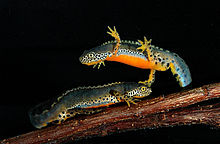Ichthyosaura
| Ichthyosaura Temporal range:
| |
|---|---|

| |
| Alpine newt, two males during mating season | |
| Scientific classification | |
| Domain: | Eukaryota |
| Kingdom: | Animalia |
| Phylum: | Chordata |
| Class: | Amphibia |
| Order: | Urodela |
| Family: | Salamandridae |
| Subfamily: | Pleurodelinae |
| Genus: | Ichthyosaura Sonnini de Manoncourt and Latreille, 1801 |
| Species | |
| |
| Synonyms[2] | |
| |
Ichthyosaura is a genus of newts in the family Salamandridae, found in Europe. The only extant species is the alpine newt (Ichthyosaura alpestris), although two fossil species are also known.[3]
Taxonomy
[edit]"Ichthyosaura", Greek for "fish lizard", refers to a nymph-like creature in classical mythology.[4]
It contains one extant species: the alpine newt (Ichthyosaura alpestris).[2] Two fossil species from the early-mid Miocene of Germany, Ichthyosaura wintershofi and Ichthyosaura randeckensis, have also been referred to this genus,[1][5] although the assignment of I. randeckensis has been challenged.[6] I. randeckensis is presently tentatively retained in Ichthyosaura.[3]
The alpine newt was long included in Triturus along with most other European newts. As this genus was found to contain several distinct evolutionary lineages, the alpine newt was split off as genus Mesotriton in 2004.[7] However, the name Ichthyosaura was published earlier and is now accepted as the valid genus name for the alpine newt, while Mesotriton is a junior synonym.[4]
Biology
[edit]The genus is gonochoric and reproduces sexually.[8]
References
[edit]- ^ a b Schoch, R.R.; Rasser, M.W. (2013). "A new salamandrid from the Miocene Randeck Maar, Germany". Journal of Vertebrate Paleontology. 33 (1): 58–66. Bibcode:2013JVPal..33...58S. doi:10.1080/02724634.2012.716113. S2CID 73644476.
- ^ a b Frost, D.R. (2020). "Ichthyosaura Sonnini de Manoncourt and Latreille, 1801. Amphibian Species of the World: an Online Reference. Version 6.1". New York, USA: American Museum of Natural History. doi:10.5531/db.vz.0001. Retrieved 28 March 2020.
- ^ a b Macaluso, Loredana; Mannion, Philip D.; Evans, Susan E.; Carnevale, Giorgio; Monti, Sara; Marchitelli, Domenico; Delfino, Massimo (2022). "Biogeographic history of Palearctic caudates revealed by a critical appraisal of their fossil record quality and spatio-temporal distribution". Royal Society Open Science. 9 (11). Bibcode:2022RSOS....920935M. doi:10.1098/rsos.220935. ISSN 2054-5703. PMC 9709575. PMID 36465678.
- ^ a b Schmidtler, J.F. (2009). "Ichthyosaura, der neue Gattungsname für den Bergmolch – ein Lehrbeispiel in Sachen Nomenklatur". Zeitschrift für Feldherpetologie (in German and English). 16: 245–250.
- ^ Sanchiz, B. (2012-01-01). "Nomenclatural notes on living and fossil amphibians". Graellsia.
- ^ Beatty, B.L.; Marjanović, D.; Witzmann, F. (2015). "An Extremely Peramorphic Newt (Urodela: Salamandridae: Pleurodelini) from the Latest Oligocene of Germany, and a New Phylogenetic Analysis of Extant and Extinct Salamandrids". PLOS ONE. 10 (9): e0137068. Bibcode:2015PLoSO..1037068M. doi:10.1371/journal.pone.0137068. ISSN 1932-6203. PMC 4589347. PMID 26421432.
- ^ García-París, M.; Montori, A.; Herrero, P. (2004). Amphibia: Lissamphibia. Fauna Iberica. Vol. 24. Madrid: Museo Nacional de Ciencias Naturales, Consejo Superior de Investigaciones Científicas. ISBN 8400082923.
- ^ "Ichthyosaura alpestris (Laurenti 1768) - Encyclopedia of Life". eol.org. Retrieved 2021-09-18.
